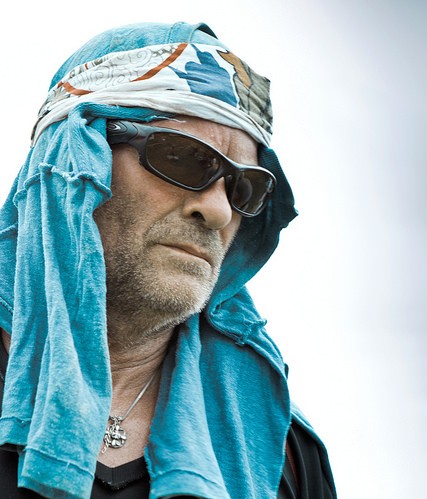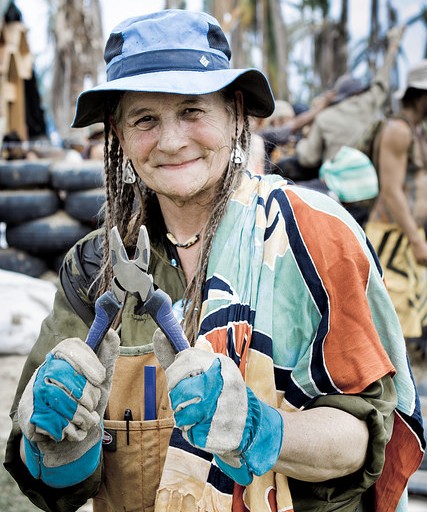John Craig, 61, Japan via Scotland
What facet or facets of Earthships is most compelling or attractive for you?
The most attractive facet of Earthships is the people who build them. Beyond question. Nothing happens without the group of people, as we’ve seen here. And like Phil said yesterday, we have four disparate groups here. We have the pros, we have the people who’ve been at the Academy, we have the volunteers and we’ve got the local community. All working together. Most of us with zero experience whatsoever in all of these different tasks.
If you were to try and do that in some academic sense, and plan it all out, and we’ve got these different nationalities, and we’ve got these different customs to consider, and the local mores. Scholars would have a field day. It’d probably take them six years to figure out how you could get all this done. And we just all bloody show up, and boom it gets done. So that is the answer to the question – the most attractive facet of the Earthship thing is the people.
A lot of people hear about Earthships for the first time and they think, that’s some crazy hippy thing. How do you get people to dispense with that mindset?
Well, you come out with the United Nations statistics. Get their attention with something real. The United Nations have got shitloads of statistics about what’s going on with the planet. And the current statistics say the following: for everybody in the world to live like the two guys sitting next to me, from advanced countries… For everybody to live like them, consume that amount of electricity, eat that much food, create that much waste… The current figure is six earths would be necessary for everybody to live the way that you do. Just take a minute to grok that…
With these six planets to get everybody to live the way that we live in terms of resources, Earthships make complete and total sense. It’s a no-brainer. We have to use materials in a much more intelligent way, and that’s being done here.
What’s it going to take to get these points across to somebody living a normal city life? Do you think it takes disasters?
Yeah.
Does New York City have to collapse?
Yeah. It’s all, yeah. They’re never going to get it. I’m not hopeful that people are just going to go, wow, isn’t that a great idea. Because the current state of consciousness in the world is, ‘well, it’s got nothing to do with me, and why should I care?’ And so it really does take a disaster. And even with a disaster, as I saw in Japan, it doesn’t necessarily produce a long-lasting change in consciousness.
There are certain people at certain times who can get something like that and just shift into a new paradigm. Like Margaret Mead said… She was an anthropologist. She said, never underestimate that a small number of people can do something absolutely enormous. And she says, in fact, that’s always the case. She’s right on. It’s a small number of people who end up making the huge change when you track it back. So from that perspective I’m extremely hopeful. But to go back into what I call the Matrix and try and talk about this, it doesn’t translate.
Christina Countryman, 59, New York, USA
What do you think we did here?
We’ve created a shelter, that when it is entirely finished will be a centerpiece of the community as part of a school and also a place to be safe during the heavy storms.
It’s also been an opportunity for the community to get to know some foreigners and to know that it’s possible to work together to create something that was hardly imaginable. We’ve created some good connections. I really admire the people of Batug. They are so resilient.
Are you interested in bringing this Windship technology back to New York? Do you think they could use it there?
Not Windship particularly, but the Earthship because we have the cold climate in New York State. This is a technology that is going to transform humanity if we can get it to be more widespread. There is a complete difference between constantly having to feed your house or having your house feed you. I think it’s going to change the way we think, the way we feel, and the way we act toward one another in a big way.
How did you first hear about Earthships and Mike Reynolds?
I’ve heard about Earthships on and off over the years. As a person in the construction industry, I have to admit that he wasn’t taken seriously early enough. And I was saying, well that’s really good and nice but how do I fit that into my life as a person who needs to support a family. I said, well that’s a nice a dream and I hope we will develop it.
I need to get more experienced with them once they’re completed, but what I imagine and what I see is not just a structure, but more of a living being with which you live. And that’s the transformation. We start recognizing that the things that support us are not just things to be taken, but actually that we have a relationship with them.
Hendry Wijaya, 37, Sumatra, Indonesia
How did you first find out about Earthships?
It began about a year and a half ago. I stumbled upon this website about Earthships and said, this guy, Michael Reynolds, has been doing it for decades. From the seventies. Way earlier than anyone else.
I looked up some of the demo videos of the working Earthships and it looked cool. And it actually works. The problem is I’m living in a tropical country. People who are aware of this are mostly from Western countries – Europeans, Americans. I was thinking about attending the Academy, but at that time I couldn’t afford the time.
And then Yolanda happens. It’s heartbreaking news. It’s really devastating. And if it can happen here, it can happen in Indonesia, right? Anytime. Somehow, Earthship the company decided to design a prototype that might work in this area, so ok, let’s dive in and see where this is going to be taken.
What do your wife and kids think of you being here?
The idea of Earthships and permaculture, she has seen me devouring these books. She understands what I am into. She gets it. And I told her, hey, I’m not going to leave home for too long. Just gonna get two weeks off, okay? I’m going to join this group of amazing people from around the world. I asked permission and she said, okay. If that’s something that you really love doing, just go for it. I was lucky, really lucky, to have an understanding wife. And the kids are still little so I think she can handle it.
Earthships have been around for decades. Why is it still such a niche?
Because it’s totally unusual. And old habits die hard. As long as we have plenty of energy, water, supplies, food, you might not think much about it. You take everything for granted. As time goes by you can imagine what habits do to your life – set, fixed. You won’t do any other way. That’s the way we live.
Do you think it takes disasters like Yolanda to break people out of that?
I’m afraid that it takes a total catastrophe to wake people up, but I hope not. This work that we’ve been doing right here right now gives a lot of hope because the people here have been hit with a disaster and the people somehow woke up. I believe that good things are coming because we have technologies. People are quite connected. It’s so much easier than any time before. I’m very optimistic about this. All these people around here are like seeds.
Be sure to catch the rest of the series!
- Part One: Michael Reynolds, Creator of Earthship Biotecture
- Part Two: Leo, Olav and Zoe, Windship Volunteers
- Part Three: Hui-Chien and Josh, Windship Volunteers
- Part Four: Florian Becquereau, Founder of Earthship Seattle
- Part Five: John Craig, Christina and Hendry, Windship Volunteers
- Part Six: Andrea Roa Buco, Community Activist and Native of Barangay Batug
- Part Seven: Maria Marasigan, Community Organizer and Earthship Activist



